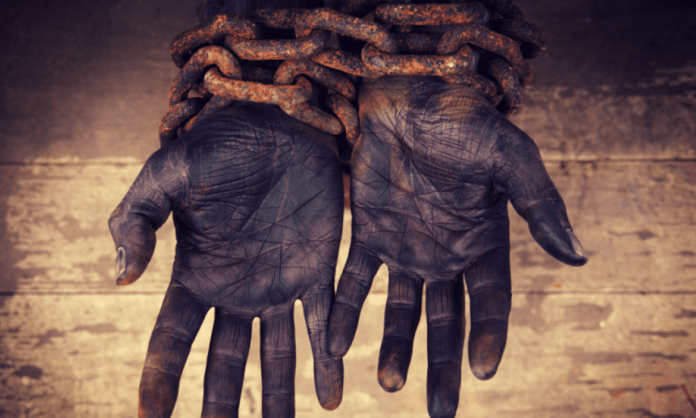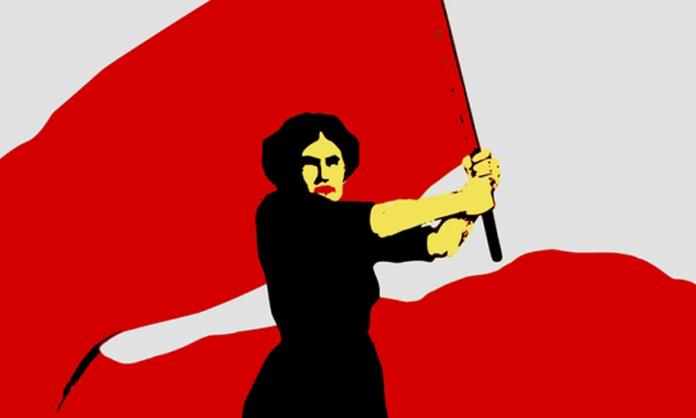Southern trees bear a strange fruit,
Blood on the leaves and blood at the root,
Black bodies swinging in the Southern breeze,
Strange fruit hanging from the poplar trees ...
“Strange Fruit” has been described as “a declaration of war ... the beginning of the civil rights movement”. When Billie Holiday first performed the song, in a New York nightclub in 1939, it had an electrifying effect. “There wasn’t even a patter of applause when I finished. Then a lone person began to clap nervously. Then suddenly, everyone was clapping”, she later wrote.
Holiday was singing about the thousands of African Americans who were tortured and murdered by racist thugs, usually with total impunity. The last recorded lynching took place as late as 1981. But the killing of Blacks by police and racist vigilantes continues to this day. Trayvon Martin, Freddy Grey, Daunte Wright, Tamir Rice, Breonna Taylor, George Floyd—the list goes on and on.
Racism is built into the fabric of US society, impacting every aspect of life. African Americans are nearly twice as likely as other Americans to live in poverty and to be unemployed; and the imprisonment rate of Blacks is more than five times the rate among whites.
But it’s not just the US. Immigrants, refugees and indigenous people everywhere are subjected to appalling treatment. And Australia is right up there with the worst. Its whole history is steeped in racism, which continues to be a defining feature of our society. Here too, young Black men are many times more likely than their white counterparts to end up in jail, or dead at the hands of the police; Indigenous people are more likely to suffer poverty, unemployment and discrimination in all walks of life. Migrant workers are super-exploited by unscrupulous employers. And if you’re fleeing persecution or war, heaven help you, because the Australian government certainly won’t. If you get here by boat, you’ll be locked up indefinitely.
Racism is a modern phenomenon, the legacy of slavery. It developed in the seventeenth and eighteenth centuries as a new class of capitalists scrambled to exploit the opportunities offered by the opening of the Americas, and as the great powers sought to extend their empires.
There weren’t enough free labourers in Europe to work the vast sugar, cotton and tobacco plantations in the colonies, so the capitalists turned to slavery. Millions of people, mainly from Africa, were forcibly transported and condemned to miserable lives and early deaths on these plantations, while producing stupendous wealth for the plantation owners.
Slavery was central to the development of European and North American capitalism, and it laid the basis for the rapid spread of capitalism as the dominant mode of production globally. “The discovery of gold and silver in America, the extirpation, enslavement and entombment in mines of the aboriginal population, the beginning of the conquest and looting of the East Indies, the turning of Africa into a warren for the commercial hunting of black-skins, signalised the rosy dawn of the era of capitalist production”, Karl Marx wrote in Capital.
In their struggle to overthrow feudalism, the rising bourgeoisie had developed an ideology that stressed “the equality of man”. How, then, to justify the enslavement and inhuman treatment of millions of human beings? This contradiction required a new ideology, one that divided human beings into a hierarchy based on their physical characteristics.
In the new ideological framework, there was supposedly a hierarchy of “races” representing different levels of human development, from “advanced” to “primitive” and even “subhuman”, with Europeans at the top and Africans at the bottom. In the nineteenth century, pseudo-scientific theories such as social Darwinism and eugenics, dreamed up by the middle-class intelligentsia, helped to legitimise racism. Eric Williams, in his book Capitalism and Slavery, concludes: “A racial twist has ... been given to what is basically an economic phenomenon. Slavery was not born of racism: rather, racism was the consequence of slavery”.
Racism’s usefulness to the capitalist class didn’t end with the demise of the slave trade. On the contrary, the now well-established ideas about race could easily be extended to people in Asia and elsewhere as their lands were colonised. The violent subjugation of indigenous peoples, the disruption of their societies, theft of their land, destruction of their culture and plundering of their resources—all these atrocities were justified by notions of racial inferiority.
And racism continues to serve imperialist interests. It’s invariably used to win popular support for wars. For example, anti-Asian racism, that enduring staple of Australian politics, was invoked against the Japanese during World War II and the Vietnamese in the 1960s and 1970s.
Racism was also useful on the domestic front. In a letter written in 1870, Marx described the divisions between English and Irish workers as “the secret of the impotence of the English working class”. “The ordinary English worker hates the Irish worker as a competitor who lowers his standard of life ... feels himself as a member of the ruling nation, and so turns himself into a tool of the aristocrats of his country ... thus strengthening their domination over himself”, he wrote. This antagonism was “artificially kept alive and intensified by the press, the pulpit, the comic papers, in short, by all the means at the disposal of the ruling class”. This, said Marx, was “the secret by which the capitalist class maintains its power. And that class is fully aware of it”.
Today, it’s this capacity of racism to divide the working class that is most useful to the capitalists. They understand that when workers accept racist ideas, it undermines class solidarity and unity. The scapegoating of particular groups divides workers against each other, blunts their understanding of who their real enemies are and thus weakens their capacity to resist exploitation.
Racism can be adapted to our rulers’ needs at any time. It can be directed against any group, at home or abroad, that they see as a problem. For example, the anti-Irish racism described by Marx and which was also a feature of post-invasion Australian society, has now largely disappeared, with other scapegoats replacing the Irish.
In more recent times we’ve seen how racism based on physical characteristics can be morphed into a racism based on supposed “cultural differences”, as with Islamophobia. This adaptability suggests that racist attitudes are not natural: they have to be continually manufactured and reinforced.
The capitalists don’t rule directly: they rely on governments to enact and enforce laws and policies in their interests. The state is not some neutral, independent body standing above society; it’s an instrument of class rule. It’s not that the politicians, judges, the heads of the public service and armed forces who run the state are racists—though of course some of them often are. But as members of the ruling class, they are committed to the maintenance of exploitation and the protection of the interests of their “own” capitalists vis-à-vis those of other countries.
In a world divided into competing nation states, the state is also the primary means by which notions of national identity are developed. Nationalism serves the capitalists’ interests by obscuring the class divide—and the partisan nature of the state itself—and persuading workers to side with their own rulers in “the national interest”. So racism is an inevitable extension of nationalism. Australia’s history provides a wealth of evidence for this.
The roots of racism in Australia lie in its origins as a white settler state in Asia: it arrived with the First Fleet as part of the baggage of empire. Racism has always been characteristic of colonial settler states, where it often assumes particularly virulent forms—think of Israel and South Africa. A major reason for this is the inconvenient presence of indigenous people.
In Australia, the Indigenous population stood in the way of the expansion of the wool industry. Aboriginal resistance to the theft of their land was savagely put down. The massacres, the introduction of disease and alcohol, the stealing of children and all the other genocidal atrocities were aimed at securing the land for capitalism.
But racism in Australia also served broader purposes. From early on, the Australian state and capitalists set out to create their own empire, dominating the region economically and politically. Racism helped to justify everything this entailed—from protecting the operations of companies like Burns Philp and BHP to invading “failed states” like the Solomon Islands.
The White Australia policy was a key element in forging the Australian nation and the Australian “identity”. It served to convince white workers that they shared a common interest with the white ruling class. The policy was supported by all the respectable institutions of society, such as the press and the churches, as well as sections of the trade union movement. However, mainstream accounts focus almost exclusively on workers and the unions. Hence the widespread view that racism comes from below, from workers, especially blue-collar workers.
This is not surprising: after all, it’s hardly in the interests of those who’ve ruled Australia since invasion to admit that the nation was founded on a racist basis, and that the national identity was built on racism. The “history wars” of the Howard era showed how important this is to the ruling class. Attempts to strip the veil from Australia’s past and reveal the ugly truth beneath were derided as a “black armband” view of history.
But socialist historians have shown how the ideology of White Australia was central to the agenda of the ruling class, and how they and their ideologues deliberately fostered racism. As Marx and Engels put it, “the ideas of the ruling class are in every epoch the ruling ideas”.
In Who are our enemies? Racism and the working class in Australia, Verity Burgmann dismisses as a historical absurdity the view that the White Australia policy was imposed by the working class to protect wages. She argues that this “attributes to the working class a degree of power and influence that is quite unrealistic. It is not logical that the middle class, let alone the capitalist class, would espouse ... White Australia ... out of any concern for working-class wage levels”.
What’s more, the adoption of the White Australia policy by the first Australian parliament occurred only a few years after important strikes by key sections of the Australian working class—maritime workers and shearers—were smashed. Yet somehow this defeated and demoralised working class is presumed to have imposed its will on a parliament in which it had virtually no representation.
Phil Griffiths, in his PhD thesis “The making of White Australia: Ruling class agendas, 1876-1888”, has thoroughly debunked the mythology surrounding the White Australia policy, arguing that it was “the product of the dominant agendas of the Anglo-Australian ruling class”.
The first agenda was strategic. Northern Australia was sparsely populated, and the ruling class feared that Chinese immigration might lead to it losing control of the area. Paranoia about invasion by “yellow hordes” (whether from China or Japan) was a constant feature of late nineteenth century Australian politics and persisted into the twentieth century.
The second agenda was economic, involving a dispute between different sectors of the capitalist class. Those in the south favoured a modern industrial economy and opposed the development in Queensland and the Northern Territory of a plantation economy based on imported indentured labour, mainly Pacific Islanders and Indians. Australia’s capitalists had no desire to repeat the recent experience in America, where the conflict between a slave-based economy in the south and one based on wage labour in the north had led to a destructive civil war. The capitalists who favoured the importation of a cheap, non-white labour force were eventually overruled.
The third agenda was the construction of a culturally homogeneous population, a society in which workers identified with their bosses on the basis of race, and class conflict was muted or deflected as a result.
These agendas reflected the class interests of the capitalists of the time. And those same class interests are responsible for the persistence of racism in Australia today. Thanks to the anti-racist movements, certain practices, language and so on are no longer acceptable—but racism continues to serve the interests of the capitalist class, as more recent Australian history shows.
Since the dawn of capitalism, the capitalists, politicians and bureaucrats who run the world have consciously and deliberately used racism to further their class interests. Racism is deeply embedded in capitalist society and all its institutions, and it’s too useful a weapon for them ever to give it up. In his book The Political Economy of Racism, Melvin Leiman argues: “As a theoretical construct, capitalism is conceivable without racism. But racism is historically rooted in the combined slave-capitalist system, and its persistence suggests that overcoming racism would require transcending capitalist society”.
In other words, to eradicate racism, we have to get to the source of the problem. The strange and bitter fruit of racism will disappear from society only once we tear out the whole capitalist system, root and branch.











